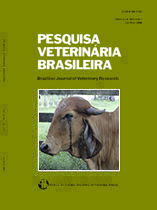 |
|
|
|
Year 2016 - Volume 36, Number 7
|

|
Detection and treatment of otitis by Rhabditis blumi in cattle of northern Brazil, 36(7):605-610
|
ABSTRACT.- Barbosa J.D., Silva J.B., Lima D.H.S., Araújo L.H.V., Santos L.L., Belo Reis A.S., Salvarani F.M. & Brito M.F. 2016. [Detection and treatment of otitis by Rhabditis blumi in cattle of northern Brazil.] Detecção e tratamento de otite por Rhabditis blumi em bovinos da região Norte do Brasil. Pesquisa Veterinária Brasileira 36(7):605-610. Instituto de Medicina Veterinária, Campus de Castanhal, Universidade Federal do Pará, Rodovia BR-316 Km 61, Castanhal, PA 68741-740, Brazil. E-mail: diomedes@ufpa.com
This study aimed to describe the occurrence of parasitic otitis caused by Rhabditis blumi in dairy cattle of the Gir race from a farm in northern Brazil. Forty-two samples were collected from cattle by swab washed from the external auditory canal (EAC). On clinical examination, in 71.4% (30/42) of the cattle the parasite was found in the cerumen of the ear canal, along with alopecia of head and hump caused by discomfort and itching of the auricular region. At microscopic analysis of material from the conjunctival sac the parasite was found in 90% (9/10) of the evaluated cattle. In addition, 9.5% (4/42) of the cattle showed nervous symptoms, such as mild to moderate rotation of the head, apathy, flaccid lips and unilateral ptosis, change in chewing and food accumulation in the oral cavity. Thirty cattle positive for Rhabditis spp. were randomly divided into three groups of 10 animals each: (G1) Cattle Control, (G2) Cattle treated with ivermectin 1% pour-on, and (G3) Cattle undergoing wash of the external auditory canal (EAC). Each treatment was repeated three times with intervals of seven days. In G1, 10 cattle remained infected throughout the study. In G2, 20% of the cattle were negative after the first two treatments, however were positive at the third evaluation. In G3, all cattle remained positive, but with decrease in parasite load. Identification by molecular analysis of amplified fragments through the expansion D2/D3 28S rDNA confirmed the presence of only Rhabditis blumi. Based on clinical, morphologic and molecular examination, it appears to be the first report of the occurrence of R. blumi infection in Gir cattle in the State of Pará, due to the purchase of cattle from areas where parasitic otitis has been diagnosed, as from Minas Gerais, to produce crossbred animals (Gir x Holstein). This emphasizes the importance of prior clinical examination by the veterinary service in order to transfer only healthy animals to other properties or regions. This appears also to be the first report on R. blumi infection of the conjunctival sac in cattle. Treatment with ivermectin in G2 did not produce clinical improvement. |
| |
|
|
| |
|
 |